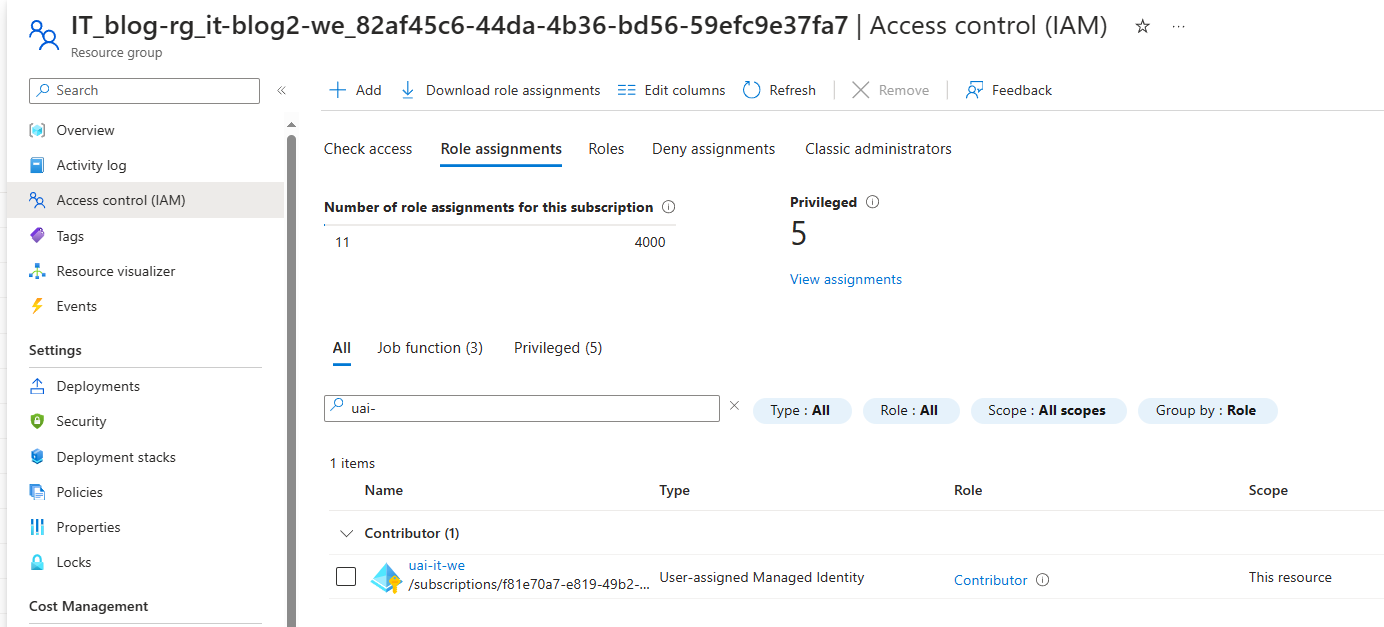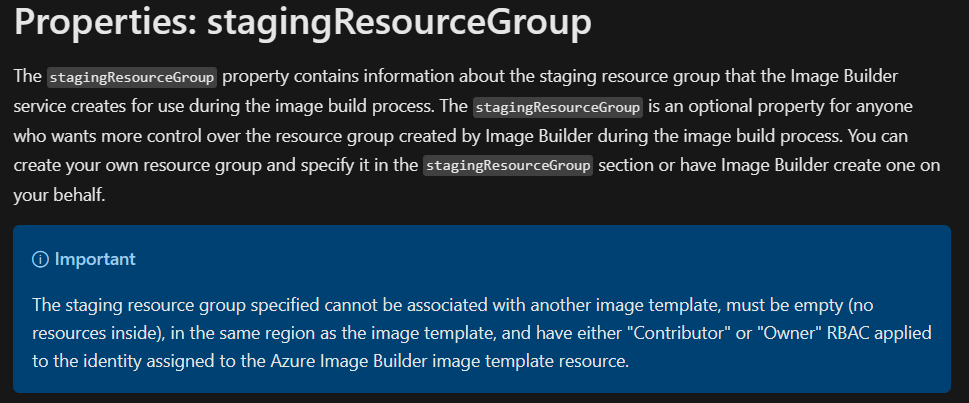Keeping sanity when working with Azure VM Image Builder
The concept is simple - I want to use Azure VM Image Builder to build a custom virtual machine image. It doesn’t matter what are the requirements, which alternative is the best, or what is the best recipe for American pancakes. I just expect, that managed services in cloud follow principle of least astonishment. As it turns out, I have very high expectations.
Short introduction
Azure VM Image Builder is a managed Azure service, which is designed to simplify creation of custom VM images. In fact, it’s just Packer-as-a-Service, which is a tool, that I like and respect. When you want to start working with that service, you just need to prepare an image template, which is basically an ARM Template / Bicep script, which you then send to Azure VM Image Builder. Such template may look just like this:
param parName string
param parLocation string = resourceGroup().location
param parIdentityName string
param parLocationSuffix string = 'we'
param parImageName string
param runSuffix string = utcNow()
param parCustomizers array
resource it 'Microsoft.VirtualMachineImages/imageTemplates@2023-07-01' = {
name: 'it-${parName}-${parLocationSuffix}'
location: parLocation
identity: {
type: 'UserAssigned'
userAssignedIdentities: {
'${uai.id}': {}
}
}
properties: {
distribute: [
{
location: parLocation
#disable-next-line use-resource-id-functions
imageId: '/subscriptions/${subscription().subscriptionId}/resourceGroups/${resourceGroup().name}/providers/Microsoft.Compute/images/${parImageName}'
runOutputName: '${parImageName}-${runSuffix}'
type: 'ManagedImage'
}
]
source: {
type: 'PlatformImage'
publisher: 'Canonical'
offer: '0001-com-ubuntu-server-jammy'
sku: '22_04-lts-gen2'
version: 'latest'
}
customize: parCustomizers
}
}
resource uai 'Microsoft.ManagedIdentity/userAssignedIdentities@2023-01-31' = {
name: 'uai-${parIdentityName}-${parLocationSuffix}'
location: parLocation
}
We could deploy such template like so and then run Image Builder to build an image:
az group create -l <some-location> -n <some-name>
az deployment group create --template-file .\image-template.bicep --parameters .\parameters.bicepparam -g <some-name>
az image builder run -n <template-name> -g <some-name>
It’ll take some time (which depends on the performance of VM used by Azure VM Image Builder), but eventually, it’ll create an image in selected location.
To select a location of built image, you need to specify proper destination using
distributeproperty. In the example below, an image would be created as standard managed image, which is a generic resource created within a resource group in a selected subscription.
To understand the service better, let’s discuss one of its main concepts.
Staging resource group
When an image is built, Azure VM Image Builder creates additional resource group called staging to deploy resources needed to build an image. If you don’t specify a custom name for that resource group, it’ll be created like so:

stagingResourceGroup property. To deploy everything with a single command, we could use subscription as deployment scope:
targetScope = 'subscription'
param parLocation string = 'westeurope'
param parName string
param parIdentityName string
param parLocationSuffix string = 'we'
param parImageName string
param parCustomizers array
resource rg 'Microsoft.Resources/resourceGroups@2023-07-01' = {
name: 'blog-ib-rg'
location: parLocation
}
resource staging_rg 'Microsoft.Resources/resourceGroups@2023-07-01' = {
name: 'blog-ib-staging-rg'
location: parLocation
}
module it 'image-template.bicep' = {
name: 'it'
scope: resourceGroup(rg.name)
params: {
parLocation: parLocation
parName: parName
parIdentityName: parIdentityName
parLocationSuffix: parLocationSuffix
parImageName: parImageName
parCustomizers: parCustomizers
parStagingResourceGroupId: staging_rg.id
}
}
Now, let’s deploy it:
az deployment sub create --location westeurope --template-file .\image-template-sub.bicep --parameters .\parameters-sub.bicepparam
It’d be too good if everything works just like that, so instead of successful deployment we have this nice error:
{"status":"Failed","error":{"code":"DeploymentFailed","target":"/subscriptions/.../providers/Microsoft.Resources/deployments/image-template-sub","message":"At least one resource deployment operation failed. Please list deployment operations for details. Please see https://aka.ms/arm-deployment-operations for usage details.","details":[{"code":"ResourceDeploymentFailure","target":"/subscriptions/.../resourceGroups/blog-ib-rg/providers/Microsoft.Resources/deployments/it","message":"The resource write operation failed to complete successfully, because it reached terminal provisioning state 'Failed'.","details":[{"code":"DeploymentFailed","target":"/subscriptions/.../resourceGroups/blog-ib-rg/providers/Microsoft.Resources/deployments/it","message":"At least one resource deployment operation failed. Please list deployment operations for details. Please see https://aka.ms/arm-deployment-operations for usage details.","details":[{"code":"ResourceDeploymentFailure","target":"/subscriptions/.../resourceGroups/blog-ib-rg/providers/Microsoft.VirtualMachineImages/imageTemplates/it-blog2-we","message":"The resource write operation failed to complete successfully, because it reached terminal provisioning state 'Failed'.","details":[{"code":"Unauthorized","message":"Not authorized to access the resource: /subscriptions/.../resourceGroups/blog-ib-staging-rg. Please check the user assigned identity has the correct permissions. For more details, go to https://aka.ms/azvmimagebuilderts."}]}]}]}]}}
All right - it worked for automatically created staging resource group, it doesn’t work for custom one. You may wonder why - well, somebody designed the service that way. The root cause is actually pretty trivial - if you don’t specify stagingResourceGroup in your template, Azure will create a role assignment for that random staging group for you:

User-assigned identity permissions
There’s a detailed guide for Azure VM Image Builder, which outlines steps needed to deploy a template and build an image. In short, it advises you to create a custom role definition:
{
"Name": "Azure Image Builder Service Image Creation Role",
"IsCustom": true,
"Description": "Image Builder access to create resources for the image build, you should delete or split out as appropriate",
"Actions": [
"Microsoft.Compute/galleries/read",
"Microsoft.Compute/galleries/images/read",
"Microsoft.Compute/galleries/images/versions/read",
"Microsoft.Compute/galleries/images/versions/write",
"Microsoft.Compute/images/write",
"Microsoft.Compute/images/read",
"Microsoft.Compute/images/delete"
],
"NotActions": [
],
"AssignableScopes": [
"/subscriptions/<subscriptionID>/resourceGroups/<rgName>"
]
}
If documentation says so, I’ll do so. Let’s add both definition and assignment to our Bicep code:
targetScope = 'subscription'
param parLocation string = 'westeurope'
param parName string
param parIdentityName string
param parLocationSuffix string = 'we'
param parImageName string
param parCustomizers array
resource rg 'Microsoft.Resources/resourceGroups@2023-07-01' = {
name: 'blog-ib-rg'
location: parLocation
}
resource staging_rg 'Microsoft.Resources/resourceGroups@2023-07-01' = {
name: 'blog-ib-staging-rg'
location: parLocation
}
resource rd 'Microsoft.Authorization/roleDefinitions@2022-04-01' = {
name: guid('Azure Image Builder Service Image Creation Role')
properties: {
roleName: 'Azure Image Builder Service Image Creation Role'
description: 'Allows Azure Image Builder to create images.'
type: 'CustomRole'
assignableScopes: [
'/subscriptions/${subscription().subscriptionId}'
]
permissions: [
{
actions: [
'Microsoft.Compute/galleries/read'
'Microsoft.Compute/galleries/images/read'
'Microsoft.Compute/galleries/images/versions/read'
'Microsoft.Compute/galleries/images/versions/write'
'Microsoft.Compute/images/write'
'Microsoft.Compute/images/read'
'Microsoft.Compute/images/delete'
]
}
]
}
}
module uai 'identity.bicep' = {
name: 'uai'
scope: rg
params: {
parIdentityName: parIdentityName
parLocation: parLocation
parLocationSuffix: parLocationSuffix
}
}
module assignment 'assignment.bicep' = {
name: 'assignment'
scope: rg
params: {
parRoleDefinitionId: rd.id
parPrincipalId: uai.outputs.outIdentityPrincipalId
}
}
module it 'image-template.bicep' = {
name: 'it'
dependsOn: [
uai
assignment
]
scope: resourceGroup(rg.name)
params: {
parLocation: parLocation
parName: parName
parLocationSuffix: parLocationSuffix
parImageName: parImageName
parCustomizers: parCustomizers
parStagingResourceGroupId: staging_rg.id
parIdentityId: uai.outputs.outIdentityId
}
}
As it turns out, it still doesn’t work:
{"status":"Failed","error":{"code":"DeploymentFailed","target":"/subscriptions/.../providers/Microsoft.Resources/deployments/image-template-sub","message":"At least one resource deployment operation failed. Please list deployment operations for details. Please see https://aka.ms/arm-deployment-operations for usage details.","details":[{"code":"ResourceDeploymentFailure","target":"/subscriptions/.../resourceGroups/blog-ib-rg/providers/Microsoft.Resources/deployments/it","message":"The resource write operation failed to complete successfully, because it reached terminal provisioning state 'Failed'.","details":[{"code":"DeploymentFailed","target":"/subscriptions/.../resourceGroups/blog-ib-rg/providers/Microsoft.Resources/deployments/it","message":"At least one resource deployment operation failed. Please list deployment operations for details. Please see https://aka.ms/arm-deployment-operations for usage details.","details":[{"code":"Conflict","message":"Update/Upgrade of image templates is currently not supported. Please change the name of the template you are submitting. If you have previously tried to submit a template and it failed to provision, you must delete it first and then resubmit. For more information, go to https://aka.ms/azvmimagebuilderts."}]}]}]}}
The role assignment is created, but it seems, that Image Template cannot be updated if we failed to provision it properly. Let’s delete it:
az image builder delete --name <template-name> --resource-group <resource-group-name>
(Unauthorized) Not authorized to access the resource: /subscriptions/.../resourceGroups/blog-ib-staging-rg. Please check the user assigned identity has the correct permissions. For more details, go to https://aka.ms/azvmimagebuilderts.
Code: Unauthorized
Message: Not authorized to access the resource: /subscriptions/.../resourceGroups/blog-ib-staging-rg. Please check the user assigned identity has the correct permissions. For more details, go to https://aka.ms/azvmimagebuilderts.
What a surprise! Because we didn’t add proper role to our user-assigned identity, what caused provisioning of a template to fail, now we’re unable to delete the template. I’d like to emphasize that, according to the documentation, we created a role, which should be enough for us, but the role itself is meant for managing VM images only. It’s not useful when we want to create a custom staging group. How to delete our image template then?
Adding missing role
In order to delete our custom staging group (or rather instruct Azure VM Image Builder to remove it as managed identity) we need to assign Contributor or comparable role to the staging resource group:
resource rd_contributor 'Microsoft.Authorization/roleDefinitions@2022-04-01' existing = {
name: 'b24988ac-6180-42a0-ab88-20f7382dd24c'
}
module assignment_contributor 'assignment.bicep' = {
name: 'assignment_contributor'
scope: staging_rg
params: {
parRoleDefinitionId: rd_contributor.id
parPrincipalId: uai.outputs.outIdentityPrincipalId
}
}
Now, when you try to delete Image Template and deploy it once again, you should be able to do so.
Conclusion
If you take a look at Image Template’s reference, you’ll see, that there’s a note, which indicates, that custom resource group for staging resources will require the role we assigned manually:

Unauthorized.
